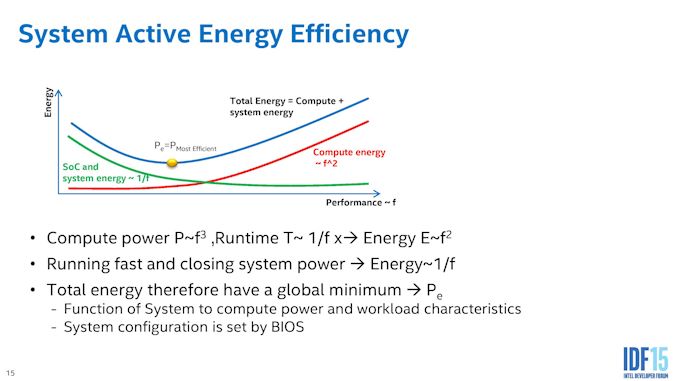Upgrading from an Intel Core i7-2600K: Testing Sandy Bridge in 2019
by Ian Cutress on May 10, 2019 10:30 AM EST- Posted in
- CPUs
- Intel
- Sandy Bridge
- Overclocking
- 7700K
- Coffee Lake
- i7-2600K
- 9700K
Power Consumption
One of the risk factors in overclocking is driving the processor beyond its ideal point of power and performance. Processors are typically manufactured with a particular sweet spot in mind: the peak efficiency of a processor will be at a particular voltage and particular frequency combination, and any deviation from that mark will result in expending extra energy (usually for better performance).
When Intel first introduced the Skylake family, this efficiency point was a key element to its product portfolio. Some CPUs would test and detect the best efficiency point on POST, making sure that when the system was idle, the least power is drawn. When the CPU is actually running code however, the system raises the frequency and voltage in order to offer performance away from that peak efficiency point. If a user pushes that frequency a lot higher, voltage needs to increase and power consumption rises.
So when overclocking a processor, either one of the newer ones or even an old processor, the user ends up expending more energy for the same workload, albeit to get the workload performed faster as well. For our power testing, we took the peak power consumption values during an all-thread version of POV-Ray, using the CPU internal metrics to record full SoC power.

The Core i7-2600K was built on Intel’s 32nm process, while the i7-7700K and i7-9700K were built on variants of Intel’s 14nm process family. These latter two, as shown in the benchmarks in this review, have considerable performance advantages due to microarchitectural, platform, and frequency improvements that the more efficient process node offers. They also have AVX2, which draw a lot of power in our power test.
In our peak power results graph, we see the Core i7-2600K at stock (3.5 GHz all-core) hitting only 88W, while the Core i7-7700K at stock (4.3 GHz all-core) at 95 W. These results are both respectable, however adding the overclock to the 2600K, to hit 4.7 GHz all-core, shows how much extra power is needed. At 116W, the 34% overclock is consuming 31% more power (for 24% more performance) when comparing to the 2600K at stock.
The Core i7-9700K, with eight full cores, goes above and beyond this, drawing 124W at stock. While Intel’s power policy didn’t change between the generations, the way it ended up being interpreted did, as explained in our article here:
Why Intel Processors Draw More Power Than Expected: TDP and Turbo Explained
You can also learn about power control on Intel’s latest CPUs in our original Skylake review:
The Intel Skylake Mobile and Desktop Launch, with Architecture Analysis











213 Comments
View All Comments
Ironchef3500 - Friday, May 10, 2019 - link
Still running one of these...warreo - Friday, May 10, 2019 - link
same here, it's still running greatNetmsm - Friday, May 10, 2019 - link
No! It dose not run great, this is 9700k that runs very disappointing.flyingpants265 - Saturday, May 11, 2019 - link
Hah, I get your point. But as of this moment, 9700k is one of the best desktop CPUs out there.Netmsm - Saturday, May 11, 2019 - link
:)It'd be better to say 9700k is one of the best Intel's desktop blah, blah, blah.
jgraham11 - Monday, May 13, 2019 - link
9700k can pump out the most frames per second but it is not the best by any means, its utilization it typically more than %80. Just like a few years ago when all those quad cores were doing so great compared to AMDs more cores and more thread approach. Now those quad cores that put out all those frames are struggling to keep up in modern titles, those AMD processors are still putting out descent frame rates! Another example of AMD's fine wine technology.With that said, is the frames per second really a good metric to determine longevity of a processor?? Or should be looking at CPU utilization as well.
lmcd - Thursday, January 21, 2021 - link
This article is old but "fine wine" about AMD's old processors is pure delusion. 2600k-age AMD looks horrible. Bulldozer was always horrible, and Piledriver has looked worse with age. Even Excavator gets absolutely smoked by most old Intel CPUs. While obviously not identical and much higher power, an Intel 3960X still went even with nearly every Ryzen 1 CPU. Fine wine my ass.yankeeDDL - Sunday, May 12, 2019 - link
Actually, this is a pretty fair summary. The 9700K, 9 years later, offers about 40% advantage over the 2600 (except in gaming, where more cores don't matter, today), which is quite abysmal.Vayra - Monday, May 13, 2019 - link
More cores don't matter? What results have you been looking at for gaming? 4K ultra?yankeeDDL - Monday, May 13, 2019 - link
Obviously, I was referring at the article. "More cores" meant going from 4 of the 2600 to 8 of the 9700. And no, they don't matter, unless you see a benefit of running at 300fps instead of 250fps. At high res, when the fps start coming close to 60fps, the 2600 and the 9700k are basically equivalent.A different story would be going from 2 to 4, but this would have nothing to do with the article...
Is it clear now?